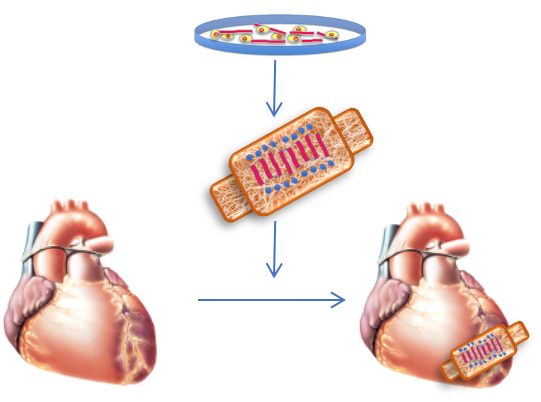Marie-Noëlle Giraud
Oberassistent_in
PER 09 - 0.105B
+41 26 300 8531
E-Mail
Heart Failure (HF) has become a rapidly growing public health issue with an estimated global prevalence between 1.3 and 6.7%. The prevention and management of chronic HF urgently requires new therapeutic approaches. Myocardial infarction remains the major cause of HF. Following a coronary ischemic event, cardiomoycytes dye. The heart has little capacity to regenerate in contract to other organs and tissues; the dead muscle is replaced by a fibrous scar. Promoting cardiac repair or regeneration is an actual. great challenge. Various cardiac repair strategies are being investigated. Among them, the administration of autologous cells associated with biological matrices has gained increasing interest.
Our research focusses on still opened questions such as the optimal source of the cells, their delivery mode, the biomarkers for responders/non-responders selection, the mechanistic understanding of the biological effect and finally the efficacy of the treatment.
In pathophysiologic conditions, the adult heart has a low regenerative capacity. We are developing a biological bandage for the treatment of the damaged myocardium. The biological bandage is composed of a matrix and cells. The therapeutic biological bandage secretes cytokines, interleukins, growth factors, exosomes that trigger the immune system, and stimulate the in-situ repair mechanisms. The biological bandage should stimulate regeneration of the damaged tissue by a functional tissue.

The immune system is essential for cardiac repair but its specific role is not yet fully understood. Myocardial injury such as ischemia induces a biphasic innate immune response from macrophages. First, proinflammatory (M1) macrophages release pro-inflammatory factors (TNF-$\alpha$ , IFN-$\gamma$) to recruit phagocytic cells for the removal of the necrotic tissues. Then, seven days after MI, anti-inflammatory (M2) macrophages are present in the damaged myocardium. M2 release anti-inflammatory mediators such as IL-10 and TGF-$\beta$ and tissue repair associated growth factors. The knowledge of the cardioprotective role of macrophages in cardiac repair is still in infancy.
We study the polarization of macrophage induced by a therapeutic cardiac bandage and its effect on cardiac repair and regeneration.
Endurance training impacts the morphology and the functionality of the heart. These cardiac effects are dependent on the type, duration and intensity of the exercise. The general recommendations of the ACSM indicate that adults should achieve, at least, 150 minutes of moderate-intensity activity or 75 min of vigorous intensity activity per week to prevent cardiovascular diseases. We investigate how endurance training can influence cardiovascular parameters to improve the prognosis after myocardial infarction.
Stent delivery is the first choice for revascularization therapies for coronary diseases. This project aims at developing a new generation of stent: a bioresorbable polymeric stent for the treatment of coronary artery diseases. A stent is a small mesh like scaffold that is placed in a lumen of artery to widen and allow blood flow to the vessel and consequently re-perfuse the ischemic myocardium. A bioresorbable, metal-free stent aims at promoting vessel healing.